African rock python
The African rock python (Python sebae) is a species of large, non-venomous snake in the family Pythonidae. The species is native to sub-Saharan Africa. It is one of 11 living species in the genus Python. It has two subspecies. One subspecies is found in Central and Western Africa, and the other subspecies is found in Southern Africa.
| African rock python | |
|---|---|
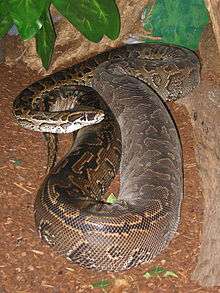 | |
| Adult female P. sebae, northern subspecies (note the thick body) | |
| Scientific classification | |
| Kingdom: | Animalia |
| Phylum: | Chordata |
| Class: | Reptilia |
| Order: | Squamata |
| Suborder: | Serpentes |
| Family: | Pythonidae |
| Genus: | Python |
| Species: | P. sebae |
| Binomial name | |
| Python sebae (Gmelin, 1788) | |
| Subspecies | |
| |
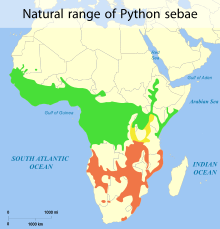 | |
Range of Python sebae sebae
Range of Python sebae natalensis
Range of hybrids | |
| Synonyms[1] | |
|
Synonymy
| |
Africa's largest snake and one of the six largest snake species in the world (along with the green anaconda, reticulated python, Burmese python, Indian python, and amethystine python), specimens may approach or exceed 6 m (20 ft). The southern subspecies is generally smaller than its northern relative. The snake is found in a variety of habitats, from forests to near deserts, although usually near sources of water. The snake becomes dormant during the dry season. The African rock python kills its prey by constriction and often eats animals up to the size of antelope, occasionally even crocodiles. The snake reproduces by egg-laying. Unlike most snakes, the female protects her nest and sometimes even her hatchlings.
The snake is widely feared, though it very rarely kills humans. Although the snake is not endangered, it does face threats from habitat reduction and hunting.
Taxonomy and etymology
The African rock python is in the genus Python, large constricting snakes found in the moist tropics of Asia and Africa. The species P. sebae is divided into two subspecies, P. s. sebae (the nominate subspecies) and P. s. natalensis (the Southern African rock python).[2] Some consider the more southerly population of this snake to be a separate species, Python natalensis,[3][4] while others consider this population to be a subspecies.[5][6]
P. sebae was first described by Johann Friedrich Gmelin, a German naturalist, in 1788. Therefore, he is also the taxon author of the nominate subspecies. The southern subspecies was first identified by South African zoologist Sir Andrew Smith, in 1833.[2][7]
The generic name, Python, is a Greek word referring to the enormous serpent at Delphi slain by Apollo in Greek mythology. The specific name, sebae, is a latinization of the surname of Dutch zoologist, Albertus Seba.[7][8] The subspecific name, natalensis, refers to the Natal region of South Africa. Common name usage varies with both the species and northern subspecies referred to as African rock python or simply rock python. The southern African rock python is sometimes referred to as the Natal rock python[7] or the African python.[9]
| Common name | Scientific name | Classified by | Year |
|---|---|---|---|
| African rock python | Python sebae sebae | Gmelin | 1788 |
| Southern African rock python | Python sebae natalensis | A. Smith | 1833 |
Description

Africa's largest snake species[3][11] and one of the world's largest,[7] the typical African rock python adult measures 3 to 3.53 m (9 ft 10 in to 11 ft 7 in) in total length (including tail), with only unusually large specimens likely to exceed 4.8 m (15 ft 9 in). Reports of specimens over 6 m (19 ft 8 in) are considered reliable, although larger specimens have never been confirmed.[12][13][14] Weights are reportedly in the range of 44 to 55 kg (97 to 121 lb), per one study adults are expected to weigh only up to 32.2 kg (71 lb). Exceptionally large specimens may weigh 91 kg (201 lb) or more.[15][16][17] On average, large adults of African rock pythons are quite heavily built, perhaps more so than most specimens of the somewhat longer reticulated as well as Indian and Burmese pythons and far more so than the Amethystine python, although the species is on average less heavily built than the green anaconda. The African species may be the second heaviest living snake with some authors agreeing that it can exceptionally exceed 90 kg (200 lb).[18][19][20] One specimen, reportedly 7 m (23 ft 0 in) in length, was killed by K. H. Kroft in 1958 and was claimed to have had a 1.5 m (4 ft 11 in) juvenile Nile crocodile in its stomach.[21] An even larger specimen considered authentic was shot in The Gambia and measured 7.5 m (24 ft 7 in).[13][14]

The snake varies considerably in body size between different areas. In general, it is smaller in highly populated regions, such as in southern Nigeria, only reaching its maximum length in areas such as Sierra Leone, where the human population density is lower. Males are typically smaller than females.[13]
The African rock python's body is thick and covered with colored blotches, often joining up in a broad, irregular stripe. Body markings vary between brown, olive, chestnut, and yellow, but fade to white on the underside.[5][11] The head is triangular and is marked on top with a dark brown “spear-head” outlined in buffy yellow. Teeth are many, sharp, and backwardly curved.[4][11] Under the eye, there is a distinctive triangular marking, the subocular mark.[5] Like all pythons, the scales of the African rock python are small and smooth.[11][22] Those around the lips possess heat-sensitive pits, which are used to detect warm-blooded prey, even in the dark.[4][22][23] Pythons also possess two functioning lungs, unlike more advanced snakes, which have only one, and also have small, visible pelvic spurs, believed to be the vestiges of hind limbs.[22][23]
The southern subspecies is distinguished by its smaller size (adults typically about 2.4 to 4.4 m in length), smaller scales on top of the head, and a smaller or absent subocular mark.[3][5]
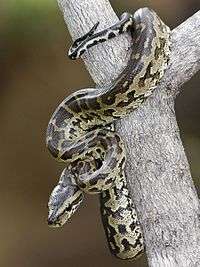 Juvenile, southern African subspecies: Note the small scales on the top of the head and the comparatively reduced markings on the side of the head.
Juvenile, southern African subspecies: Note the small scales on the top of the head and the comparatively reduced markings on the side of the head. Head of African subspecies: Note the large scales on the top of the head.
Head of African subspecies: Note the large scales on the top of the head.
Distribution and habitat
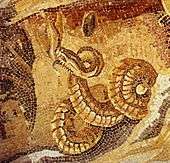
The African rock python is found throughout almost the whole of sub-Saharan Africa,[24] from Senegal east to Ethiopia and Somalia and south to Namibia and South Africa.[6][11] Python sebae sebae ranges across central and western Africa, while P. s. natalensis has a more eastern and southerly range, from southern Kenya to South Africa.[3]
In 2009, an African rock python was found in the Florida Everglades.[25] It is feared to be establishing itself as an invasive species alongside the already-established Burmese python. Feral rock pythons were also noted in the 1990s in the Everglades.[12]
The African rock python inhabits a wide range of habitats, including forest, savanna, grassland, semidesert, and rocky areas. It is particularly associated with areas of permanent water,[5][26] and is found on the edges of swamps, lakes, and rivers.[3][11] The snake also readily adapts to disturbed habitats, so is often found around human habitation,[24] especially cane fields.[7]
- African subspecies, Senegal National Park
 Southern African subspecies, edge of the Cuando River, Botswana
Southern African subspecies, edge of the Cuando River, Botswana- Southern African subspecies in the wild
Ecology and biology
Feeding
Like all pythons, the African rock python is non-venomous and kills its prey by constriction.[4][23] After gripping the prey, the snake coils around it, tightening its coils every time the victim breathes out. Death is thought to be caused by cardiac arrest rather than by asphyxiation or crushing.[4] The African rock python feeds on a variety of large rodents, monkeys, warthogs, antelopes, vultures, fruit bats, monitor lizards, crocodiles, and more in forest areas,[11] and on rats, poultry, dogs, and goats in suburban areas. Occasionally, it may eat the cubs of big cats such as leopards, lions, and cheetahs, cubs of hyenas, and puppies of wild dogs such as jackals and Cape hunting dogs.. However, these encounters are very rare, as the adult cats can easily kill pythons or fend them off.[27][14] On March 1, 2017, a 3.9-m (12-ft. 10-in) African rock python was filmed eating a small adult female spotted hyena weighing 50 kg (120 lb). This encounter suggests that the snake might very well be capable of hunting and killing larger and more dangerous animals than previously thought.[28]
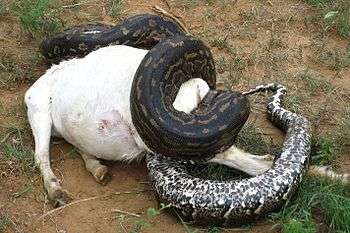 Constricting a pregnant goat
Constricting a pregnant goat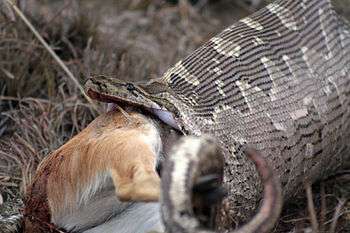 Stretching to consume an antelope
Stretching to consume an antelope
Reproduction
Reproduction occurs in the spring.[7] African rock pythons are oviparious, laying between 20 and 100 hard-shelled, elongated eggs in an old animal burrow, termite mound, or cave.[3][11] The female shows a surprising level of maternal care, coiling around the eggs, protecting them from predators, and possibly helping to incubate them, until they hatch around 90 days later.[3][4][11] The female guards the hatchlings for up to two weeks after they hatch from their eggs to protect them from predators in a manner unusual for snakes in general and pythons in particular.[29]
Hatchlings are between 45 and 60 cm (17.5 and 23.5 in) in length and appear virtually identical to adults, except with more contrasting colors.[7] Individuals may live over 12 years in captivity.[30]
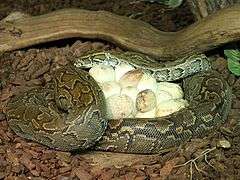
Brooding eggs 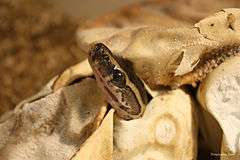
Hatching 
Newborn
Human interaction
Attacks

Documented attacks on humans are exceptionally rare, despite the species being common in many regions of Africa, and living in diverse habitats including those with agricultural activity.[24] Few deaths are well-substantiated, with no reports of a human being consumed.[24] Large specimens (which are more common in Western Africa) "would have no difficulty in eating adult humans."[24] Though it would have to be a small adult human.
Well-substantiated attacks
- A scholarly article published in 1980 said no prior well-substantiated fatalities were reported of humans killed by African rock pythons, and the only prior such attack by any type of python or boa was by a reticulated python in 1927.[24]
- In 1979 in Waterberg District, Limpopo Province (then Northern Transvaal), South Africa, a 4.5-m African rock python killed a 13-year-old boy.[24] The victim died due to suffocation and internal injuries; his body was released by the python after intervention by an adult man some 20 minutes after the attack began.[24] The victim's head was covered in saliva, and scientists thought "it could have easily succeeded in swallowing" the 1.3-m, 45-kg boy had it not been interrupted.[24]
- In 1999 in Centralia, Illinois, a 3-year-old boy was suffocated during the night by an escaped 2.3 m (7.5 ft) pet African rock python.[31][32] Bite marks around the boy's neck and ears may have resulted from an attempt to swallow him.[31]
- In 2013 in Campbellton, New Brunswick, Canada, two brothers aged four and six were reportedly killed by a 4.3-to-4.9 m (14-to-16 ft), 45 kg (99 lb) African rock python kept by a pet shop owner.[33][34] The circumstances of the incident prompted some skepticism from experts not involved in the case,[34] An autopsy showed that the boys died of asphyxiation,[33] which does not fit with how constricting snakes kill.[35] The owner was charged with criminal negligence for not adequately protecting the boys from the snake.[36][37] (See main article).
- In 2017, an 2.4-metre-long (8 ft) female rock python, kept as a pet in Hampshire, England, was found to have killed its owner by asphyxiation, according to a coroner's inquest.[38]
Other reported attacks
- In 2002 near Durban, South Africa, a 10-year-old boy was reportedly swallowed by an African rock python over a three-hour period, as seven other children stayed hidden in a mango tree.[39][40] The animal was not captured and the story could not be verified, although detailed descriptions of the snake's markings and predation technique were reported to have seemed credible to a local snake park operator.[39]
- In 2009 in Sabaki Village, Malindi District, Kenya, a male farm manager was reportedly attacked after stepping on a 13-ft python, the exact species of which was not determined. After an hour's struggle, he was reportedly dragged up a tree, but then rescued by police and villagers after he was able to call for help on his mobile phone.[41][42] The snake was reportedly captured by police, but had escaped and disappeared by the next day.[41] The man said he bit the snake's tail while he was being attacked and was injured on his lower lip because the tip of the tail was sharp.[41]
Bushmeat
As the mammalian and avian game populations are gradually depleted in the Congo Basin, the proportion of large-bodied snakes offered at rural bushmeat markets increases. Consequently, a large proportion of the human population faces the threat of Armillifer armillatus infections, a python-borne zoonotic disease.[43]
Conservation
People are often fearful of large pythons and may kill them on sight.[3][24] The African rock python may also be threatened by hunting for leather in some areas.[44] It is also collected for the pet trade, although it is not generally recommended as a pet due to its large size and unpredictable temperament.[30] Little information is available on levels of international trade in this species.
Some of the African rock python's habitats are also known to be under threat. For example, mangrove and rainforest habitats and their snake communities are under serious threat in southeastern Nigeria from habitat destruction and exploration for the oil industry.[44][45]
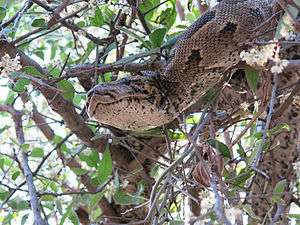
The African rock python is still relatively common in many regions across Africa, and may adapt to disturbed habitats,[24] provided that food is available. It is not currently considered at risk of extinction, but is listed on Appendix II of the Convention on International Trade in Endangered Species, meaning international trade in African rock pythons should be carefully monitored and controlled,[6] giving wild populations some protection from overcollection for pets and skins. The species is also likely to occur in a number of protected areas, such as the Serengeti National Park in Tanzania, a World Heritage site.[46]
In the Florida Everglades, where the African rock python is an invasive species and posing a threat to indigenous wildlife, it has no protected status and is one of the species listed on a hunting program recently authorized by state officials to eradicate non-native reptiles, the others being the Burmese python, reticulated python, green anaconda, and Nile monitor.
In culture
Luo people of Kenya living mainly in the area near Lake Victoria generally consider snakes to be evil and believe that sorcerers make them harm people.[47] Towards pythons, they express different attitude - such as making them appear in play songs and even worshiping. The Luo call the African rock python ng'ielo in their language,[48] and with the songs containing a phrase ng'ielo jadhogre “python the coiling”, children make a line and imitate a python's motion.[49][50][51] The Luo call every gentle python, which appears almost decade by decade, Omieri (or Omweri) and worship her, regarding her as a reincarnation of a woman and linked with rain and fertility.[47] The one which appeared in 2003 raised controversy over how she should be treated and parts of this fever were later covered by even the BBC News through the Daily Nation.[52][53][47]
References
This article incorporates text from the ARKive fact-file "African rock python" under the Creative Commons Attribution-ShareAlike 3.0 Unported License and the GFDL.
- McDiarmid RW, Campbell JA, Touré TA (1999). Snake Species of the World: A Taxonomic and Geographic Reference, Volume 1. Washington, District of Columbia: Herpetologists' League. ISBN 1-893777-00-6 (series). ISBN 1-893777-01-4 (volume).
- "Python sebae". Integrated Taxonomic Information System. Retrieved 12 September 2007.
- O’Shea M (2007). Boas and Pythons of the World. London: New Holland Publishers. ISBN 1-84537-544-0.
- Schmidt W (2006). Reptiles and Amphibians of Southern Africa. Cape Town, South Africa: Struik. ISBN 1-77007-342-6.
- Bartlett PP, Wagner E (2009). Pythons. New York: Barron’s Educational Series. ISBN 0-7641-4244-5.
- "CITES". CITES.
- Mehrtens JM (1987). Living Snakes of the World in Color. New York: Sterling Publishers. ISBN 0-8069-6460-X.
- Beolens, Bo; Watkins, Michael; Grayson, Michael (2011). The Eponym Dictionary of Reptiles. Baltimore: Johns Hopkins University Press. xiii + 296 pp. ISBN 978-1-4214-0135-5. (Python sebae, p. 240).
- Ditmars RL (1933). Reptiles of the World. Revised Edition. The MacMillan Company.
- "ITIS Standard Report Page: Python sebae". Integrated Taxonomic Information System. Retrieved 23 December 2013.
- Alden PC, Estes RD, Schlitter D, McBridge B (1996). Collins Guide to African Wildlife. London: HarperCollins Publishers. ISBN 000220066X.
- Murphy JC, Henderson RW (1997). Tales of Giant Snakes: A Historical Natural History of Anacondas and Pythons. Krieger Pub. Co. ISBN 0-89464-995-7.
- Starin ED, Burghardt GM (1992). "African rock pythons (Python sebae) in the Gambia: observations on natural history and interactions with humans". The Snake. 24: 50–62.
- Luiselli L, Angelici FM, Akani GC (2001). "Food habits of Python sebae in suburban and natural habitats". African Journal of Ecology. 39: 116–118. doi:10.1111/j.1365-2028.2001.00269.x.
- Spawls S, Howell K, Drewes R, Ashe J (2002). A Field Guide to Reptiles of East Africa. San Diego, California: Academic Press.
- Spawls S, Branch B (1995). The Dangerous Snakes of Africa. South Africa: Southern Book Publishers, Ltd.
- Ott BD, Secor SM (2007). "Adaptive regulation of digestive performance in the genus Python ". Journal of Experimental Biology 210 (2): 340-356.
- Murphy, J. C., & Henderson, R. W. (1997). Tales of giant snakes: a historical natural history of anacondas and pythons. Florida: Krieger Publishing Company.
- Vincent, S. E., Dang, P. D., Herrel, A., & Kley, N. J. (2006). Morphological integration and adaptation in the snake feeding system: a comparative phylogenetic study. Journal of evolutionary biology, 19(5), 1545-1554.
- Bodson, L. (2003). A Python (" Python sebae" Gmelin) for the King: The Third Century BC Herpetological Expedition to Aithiopia (Diodorus of Sicily 3.36–37). Museum Helveticum, 60(1), 22-38.
- Wood, Gerald (1983). The Guinness Book of Animal Facts and Feats. ISBN 978-0-85112-235-9.
- Branch, Bill (1998). Field Guide to Snakes and Other Reptiles of Southern Africa. Cape Town, South Africa: Struik. ISBN 1868720403.
- Halliday T, Adler K (2002). The New Encyclopedia of Reptiles and Amphibians. Oxford: Oxford University Press. ISBN 0-19-852507-9.
- Branch WR, Hacke WD (1980). "A fatal attack on a young boy by an African rock python Python sebae". Journal of Herpetology. 14 (3): 305–307. doi:10.2307/1563557. JSTOR 1563557.
- "Largest African Rock Python caught in Everglades". WBBH (NBC-2 News). Retrieved 5 April 2012.
- Luiselli L, Akani GC, Eniang EA, Politano E (2007). "Comparative ecology and ecological modeling of sympatric pythons, Python regius and Python sebae. In: Henderson RW, Powell R (Editors) (2007). Biology of the Boas and Pythons. Eagle Mountain, Utah: EMP Press. ISBN 0972015434.
- Sandeep, Sharma (2004). "An observation on suspected death of Indian Rock Python (Python molurus molurus) because of Jungle Cat (Felis chaus)" (PDF). South Asian Reptile Network Newsletter. 6: 1.
- http://news.nationalgeographic.com/2017/03/snakes-pythons-africa-hyena-kill/
- Alexander, Graham; Johan Marais (2008). A Guide to the Reptiles of Southern Africa. Struik Publishers. ISBN 978-1-77007-386-9.
- Bartlett PP, Griswold B, Bartlett RD (2001). Reptiles, Amphibians, and Invertebrates: An Identification and Care Guide. New York: Barron’s Educational Series. ISBN 0-7641-1650-9.
- "Centralia family's python suffocates 3-year-old boy". Chicago Tribune. 30 August 1999. Retrieved 31 March 2018.
- "AGN: Couple acquitted in child's death by python". Amarillo Globe-News. 25 March 2000.
- "Reports into boys' python deaths still under wraps". CBC News. Canadian Broadcasting Corporation. 12 September 2013. Retrieved 31 March 2018.
- Boesveld, Sarah (6 August 2013). "'Very, very strange': Snake handlers, experts baffled by New Brunswick python attack". National Post. Postmedia Network Inc.
- Gill, Victoria (23 July 2015). "Boa constrictors' lethal secret revealed". BBC News. Retrieved 1 April 2018.
- "Man charged in python asphyxiation death of boys". Toronto Star. March 31, 2015. Retrieved March 31, 2018.
- "Archived copy". Archived from the original on 2017-08-06. Retrieved 2018-04-01.CS1 maint: archived copy as title (link) CS1 maint: BOT: original-url status unknown (link)
- "Snake owner killed by his pet python". BBC News. 24 January 2018.
- Flanagan, Jane (24 November 2002). "Hunt for giant snake that ate 10-year-old Durban boy whole". The Telegraph. Johannesburg: Telegraph Media Group Limited.
- Ayoob, Zoobair (23 November 2002). "Boy quiet as snake swallows him". News24. 24.com.
- Nyassy, Daniel (14 April 2009). "Man bites snake in hour-long battle to survive". Daily Nation. Nation Media Group. Archived from the original on 24 December 2013.
- "Man bites snake in epic struggle". BBC News. 15 April 2009. Retrieved 15 April 2009.
- Hardi R, et al. (2017). "Armillifer-infected snakes sold at Congolese bushmeat markets represent an emerging zoonotic threat". EcoHealth. 14 (3). doi:10.1007/s10393-017-1274-5. PMC 7088293.
- Luiselli L, Akani GC (2002). "An investigation into the composition, complexity and functioning of snake communities in the mangroves of south-eastern Nigeria". African Journal of Ecology. 40 (3): 220–227. doi:10.1046/j.1365-2028.2002.00358.x.
- Akani GC, Barieenee IF, Capizzi D, Luiselli L (1999). "Snake communities of moist rainforest and derived savanna sites of Nigeria: biodiversity patterns and conservation priorities". Biodiversity and Conservation. 8 (5): 629–642. doi:10.1023/A:1008849702810.
- "Serengeti National Park, Tanzania" (PDF). UNEP-WCMC. Archived from the original (PDF) on 2009-07-13.
- Smith, James H. (2006). "Snake-driven development: Culture, nature and religious conflict in neoliberal Kenya". Ethnography. 7 (4): 423–59. JSTOR 24047925.CS1 maint: ref=harv (link)
- Kokwaro, John O.; Johns, Timothy (1998). Luo Biological Dictionary. Nairobi and Kampala and Dar es Salaam: East African Educational Publishers. p. 257. ISBN 9966 46 841 2.CS1 maint: ref=harv (link)
- Miruka, Okumba (2001). Oral Literature of the Luo. Nairobi and Kampala and Dar es Salaam: East African Educational Publishers. ISBN 9966 25 086 7.CS1 maint: ref=harv (link)
- Miya, Florence N. (2007). "Using African Indigenous Knowledge Systems in Early Childhood Music Education." In Katharine Smithrim and Rena Upitis (eds.) Listen to Their Voices: Research and Practice in Early Childhood Music, pp. 161–180. Waterloo, Canada: Canadian Music Educators' Association. ISBN 978-0-920630-13-6
- Owen, J. W. (1959). "Tribal games and dances in African schools". Physical Education. 51: 16–20.CS1 maint: ref=harv (link)
- "Kenyans charmed by snake". BBC News. 11 March 2003. Retrieved 1 April 2018.
- "Kenya python tightens its grip". BBC News. 15 May 2003. Retrieved 1 April 2018.
Further reading
- Boulenger GA (1893). Catalogue of the Snakes in the British Museum (Natural History). Volume I., Containing the Families ... Boidæ ... London: Trustees of the British Museum (Natural History). (Taylor and Francis, printers). xiii + 448 pp. + Plates I-XXVIII. (Python sebae, pp. 86–87).
- Gmelin JF (1788). Caroli a Linné Systema Naturae. Editio Decima Tertia [13th edition]. Tomus 1, Pars 3. Leipzig: G.E. Beer. 1,896 pp. (Coluber sebae, new species, p. 1118). (in Latin).
External links
| Wikimedia Commons has media related to African rock python. |
| Wikispecies has information related to Python sebae |
- African rock python media from ARKive

- Python sebae at the Reptarium.cz Reptile Database. Accessed 12 September 2007.